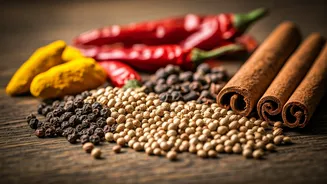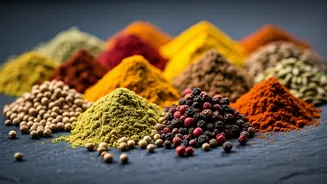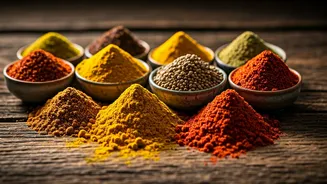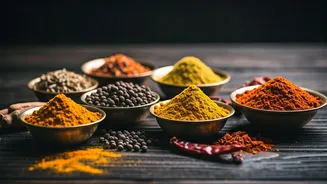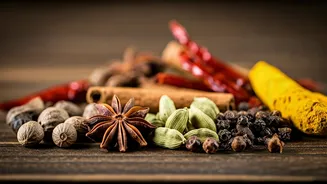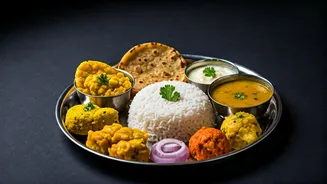A Culinary Landscape
Indian cuisine is renowned for its remarkable diversity, with each region boasting unique culinary styles and dishes. This variety reflects the country's
vast geography, diverse cultures, and historical influences. For instance, the northern regions often feature rich, creamy curries and tandoor-cooked meats, heavily influenced by Mughal rule. Think of the iconic butter chicken, a testament to this influence. Moving south, you'll encounter lighter, more vegetable-focused dishes, often featuring coconut milk, lentils, and a plethora of fresh spices. The coastal areas emphasize seafood, prepared with aromatic masalas and a tropical flair. Further east, the cuisine is influenced by the proximity to China and Southeast Asia, leading to dishes with subtle spices and unique cooking methods. West Indian cuisine, on the other hand, embraces a fusion of influences, resulting in dishes like vindaloo that showcase the bold flavors of the Portuguese influence. This regional variation not only provides a diverse culinary experience but also offers insight into the history and cultural fabric of each area.
The Spice Route Journey
Spices are at the heart of Indian cuisine, contributing depth, complexity, and distinct aromas to dishes. The use of spices dates back thousands of years and is deeply intertwined with India's history as a global trading hub. The spice trade brought in diverse ingredients and culinary techniques from different cultures, enriching the country's cooking styles. Common spices include turmeric, known for its vibrant color and anti-inflammatory properties; cumin, providing a warm, earthy flavor; coriander, offering a fresh, citrusy note; and cardamom, adding a delicate sweetness. Chili peppers, introduced from the Americas, have also become integral, adding heat to many dishes. The art of using spices involves understanding their flavor profiles and the techniques of blending them in precise proportions. This process, often passed down through generations, is crucial in creating the perfect balance of flavors in each dish. For example, a masala, a spice blend, can be dry-roasted or freshly ground to release its full flavors. The mastery of spice combinations is what gives Indian cuisine its unique and complex character, distinguishing it from other culinary traditions globally. Each spice contributes distinct flavors, aroma, and visual appeal, and in synergy, they create a balanced and memorable dining experience.
Essential Cooking Techniques
Indian cooking involves a range of techniques that have evolved over centuries, each contributing to the unique character of the cuisine. One of the fundamental techniques is the use of tadka, or tempering, where spices are briefly fried in hot oil or ghee to release their flavors before being added to a dish. This creates an aromatic base that enhances the taste and aroma of the final product. Another key technique is slow cooking, used extensively to develop flavors. This is common in various dishes, like biryanis and curries, where ingredients are simmered for an extended period, allowing the flavors to meld and deepen. Tandoor cooking, originating from the Persian influence, is also a signature method, where food, particularly meats and breads, are cooked in a clay oven at high temperatures. The intense heat gives the food a unique smoky flavor and characteristic charred texture. Grinding and blending spices using a mortar and pestle or a traditional stone grinder is also a vital aspect. Freshly ground spices impart a vibrant and robust flavor that dried alternatives often lack. Another important aspect of Indian cooking is the use of different types of cooking fats, such as ghee (clarified butter), which contributes a rich, nutty flavor, and various vegetable oils, each imparting a subtle flavor profile to the dishes. The mastery of these techniques, from tempering spices to slow cooking, sets Indian cuisine apart and is the key to creating authentic flavors.
Iconic Dishes Unveiled
Indian cuisine is celebrated globally for its iconic dishes, each reflecting regional culinary practices and preferences. Butter chicken, a creamy, tomato-based curry with tender chicken, is arguably one of the most recognizable dishes from the northern part of India. The dish is a blend of Mughlai and Punjabi influences. Another popular dish is biryani, a flavorful rice dish often layered with meat, vegetables, and aromatic spices, with its origins rooted in Persian cuisine. Its preparation varies significantly by region. Dosa, a thin crepe made from fermented rice and lentil batter, is a South Indian staple. It's often served with sambar (a lentil-based vegetable stew) and chutney. Samosas, a deep-fried pastry filled with spiced potatoes, peas, and other vegetables, are a classic snack found across India, perfect for any occasion. Another highly recognized dish is Chole Bhature, a hearty combination of spicy chickpea curry (chole) and fluffy fried bread (bhature), originating from the Punjabi region. Dishes like these showcase the diverse flavor profiles and cooking styles present in Indian cuisine, and they represent a significant part of the country's cultural identity. They highlight the artistry and diversity of Indian food.
The Cultural Significance
Food in India holds deep cultural and spiritual significance. It's not just a means of sustenance, but also a central component of celebrations, rituals, and daily life. Many Indian festivals and ceremonies are incomplete without specific foods, often symbolizing prosperity, good health, and auspicious beginnings. For example, during Diwali, the festival of lights, sweets and savories are prepared and shared, symbolizing the triumph of light over darkness. At weddings, elaborate feasts are served, with dishes meticulously selected to honor the occasion and bring blessings to the couple. The act of sharing food, especially homemade meals, is a sign of hospitality and familial bonds. In many Indian homes, cooking is a communal activity, with family members contributing to the preparation of meals. Food practices and preferences vary significantly by religious beliefs and traditions. For instance, vegetarianism is common, particularly in communities that follow Hinduism and Jainism, where the emphasis is on plant-based diets. The concept of 'seva', or selfless service, is often reflected in how food is prepared and offered, whether to guests or the less fortunate. The rich symbolism of food is an integral aspect of the cultural landscape, strengthening social connections and cultural identity across the country.
